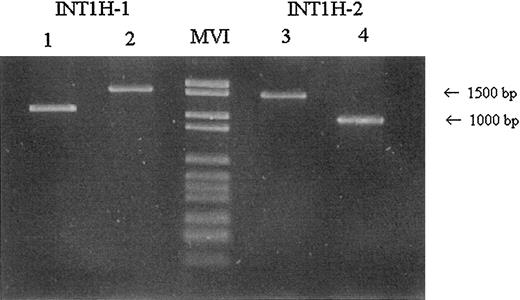Bagnall and collegues1 report a technique to investigate an inversion that disrupts the factor VIII (F8) gene and that represents a frequent cause of severe hemophilia A. This large genomic rearrangement, identified for the first time by Brinke et al2 in 2 haemophilic monozygotic twins, affects intron 1 of the F8 gene. Bagnall et al1 demonstrated that this inversion of intron 1 derives from a homologous recombination between 2 nearly identical 1041–base pair (bp) sequences, int1h-1 andint1h-2, in opposite orientation, positioned respectively in intron 1 of the gene and in a more telomeric region, 140 kilobases (kb) downstream, between the C6.1A andVBPI genes. This rearrangement results in the production of 2 chimeric mRNAs; the first, possibly under the control of the F8 gene promoter, contains the first exon of the F8gene, followed by some exons of VBP1. The other chimeric mRNA, under control of the C6.1A gene promoter, contains almost all of the coding region of the C6.1A gene followed by part of intron 1 and exon 2 to 26 of the F8 gene.
We have examined 28 patients with severe to moderate hemophilia A (21 with severe, 2 with moderately severe, and 5 with moderate hemophilia A phenotype). All of the patients were investigated for the inversion of intron 223,4; 8 of them are characterized by the presence of this common mutation. The other affected males that were negative for the inversion of intron 22 were screened for the inversion of intron 1; this mutation occurs repeatedly and seems to have a prevalence of 5% in patients with severe disease in the United Kingdom.1
We have performed an analysis directly on genomic DNA extracted with a QIAamp DNA blood mini-kit (QIAGEN, Hilden, Germany) under polymerase chain reaction (PCR) conditions suggested by Bagnall et al.1 We performed 2 amplifications. One reaction contained 3 different primers: 9F and 9cR, specific for theint1h-1 region, and int1h-2F, which is specific for the region flanking int1h-2. The other reaction contained 2 primers, int1h-2F and int1h-2R, which are specific for the amplification of the int1h-2 region, and a third primer, 9F, which flanks the telomeric side of the int1h-1region. These PCRs are able to differentiate wild type from the patients with inversion and the patients with inversion from carriers. The amplified segments were readily separated on a 1.5% agarose gel. One patient out of 20 with severe disease tested positive for intron 1 inversion (Figure 1).
Amplification of int1h-1 and int1h-2 regions.
Regions were amplified using 9F, 9cR, and Int1h-2F primers (lanes 1,2), and int1-2F, int1h-2R, and 9F primers (lanes 3,4). Lanes 1 and 3 show a male with inversion; lanes 2 and 4 show a wild-type male. MVI indicates DNA molecular weight marker VI (Boehringer Mannheim, Mannheim, Germany). The dimensions of the amplified fragments are approximately 1500 bp and 1000 bp.
Amplification of int1h-1 and int1h-2 regions.
Regions were amplified using 9F, 9cR, and Int1h-2F primers (lanes 1,2), and int1-2F, int1h-2R, and 9F primers (lanes 3,4). Lanes 1 and 3 show a male with inversion; lanes 2 and 4 show a wild-type male. MVI indicates DNA molecular weight marker VI (Boehringer Mannheim, Mannheim, Germany). The dimensions of the amplified fragments are approximately 1500 bp and 1000 bp.
These observations demonstrate, in accordance with Bagnall et al, that this approach is a rapid and efficient method for the individuation of intron 1 inversion and it should be routinely performed in patients with severe hemophilia A.


This feature is available to Subscribers Only
Sign In or Create an Account Close Modal